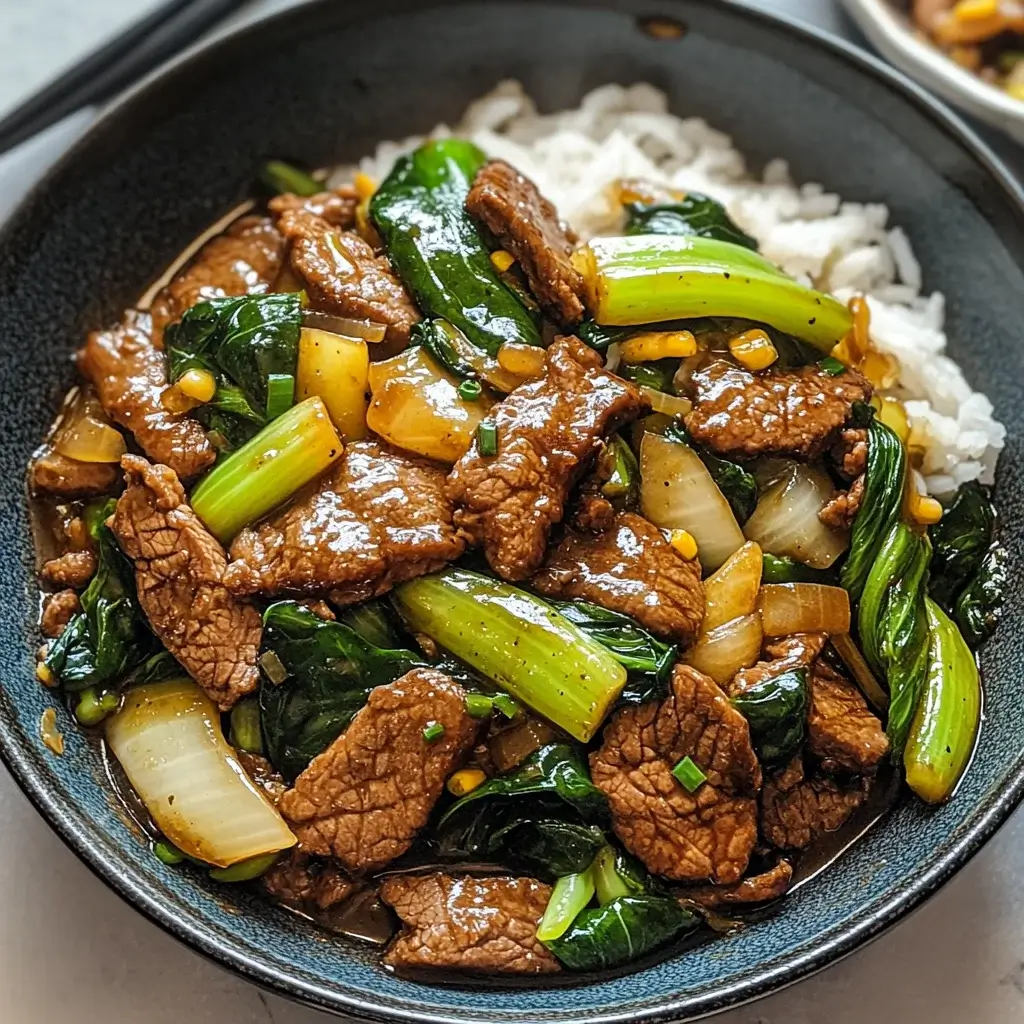Life can be hectic, especially when juggling work, family, and everything in between. Weeknights often feel like a race against the clock, and dinner can easily become an afterthought. Takeout menus start to look tempting, but I always crave something healthier and homemade. That’s where my Beef and Bok Choy Stir Fry recipe comes to the rescue. It’s become a true weeknight wonder in our home – quick, nutritious, and bursting with flavor that even my pickiest eaters devour.
Honestly, stir-fries were initially intimidating to me. I imagined complicated techniques and a sink full of dishes. But this Beef and Bok Choy Stir Fry completely changed my perception. It’s surprisingly simple to prepare, coming together in under 30 minutes, from chopping board to table. The vibrant colors of the bok choy and the savory aroma of the beef sizzling in the wok fill the kitchen with warmth and anticipation.
What truly makes this recipe a winner in my book is its incredible versatility. Need to use up leftover vegetables? Toss them in! Want to adjust the spice level? Easy peasy. It’s a blank canvas for culinary creativity, and yet, even in its simplest form, it’s absolutely delicious. My family loves the tender beef, the slightly sweet and crunchy bok choy, and the savory sauce that coats everything perfectly. It’s a dish that satisfies our cravings for both comfort food and healthy eating, all in one delightful package. So, let me share this recipe with you, hoping it becomes your go-to weeknight meal solution and a family favorite in your home too!
Ingredients: The Building Blocks of Flavorful Stir Fry
The key to a truly exceptional Beef and Bok Choy Stir Fry lies in the quality and freshness of your ingredients. Each component plays a vital role in building the layers of flavor and texture that make this dish so satisfying. Here’s what you’ll need to create this delicious and healthy stir fry:
- 1 pound Beef Sirloin or Flank Steak: These cuts are ideal for stir-frying as they are relatively lean and tender when sliced thinly against the grain. Sirloin offers a good balance of flavor and tenderness, while flank steak is known for its rich beefy taste. Look for well-marbled beef for the best flavor and texture. You can also use other cuts like ribeye or skirt steak, but adjust cooking time accordingly.
- 1 pound Bok Choy: Bok choy, also known as Chinese cabbage, is the star vegetable in this stir fry. It has a mild, slightly sweet flavor and a wonderful crunchy texture that holds up well in stir-frying. Choose bok choy with firm, crisp stalks and vibrant green leaves. Both baby bok choy and mature bok choy work well; baby bok choy is more tender and cooks faster, while mature bok choy has a slightly stronger flavor.
- 2 tablespoons Soy Sauce (Low Sodium Preferred): Soy sauce is the foundation of the stir fry sauce, providing umami, saltiness, and depth of flavor. Using low-sodium soy sauce allows you to control the salt level and is generally healthier. Tamari (gluten-free soy sauce) can be used as a substitute.
- 2 tablespoons Oyster Sauce: Oyster sauce adds a rich, savory, and slightly sweet flavor that is characteristic of many authentic stir-fry dishes. It provides a depth of flavor that soy sauce alone cannot achieve. If you are vegetarian or vegan, you can substitute with vegetarian oyster sauce made from mushrooms.
- 1 tablespoon Cornstarch: Cornstarch is used to tenderize the beef and thicken the stir fry sauce, creating a glossy and flavorful coating that clings to the beef and bok choy. Arrowroot powder can be used as a gluten-free alternative.
- 1 tablespoon Rice Wine or Dry Sherry: Rice wine (like Shaoxing wine) or dry sherry adds a subtle sweetness and complexity to the sauce, enhancing the overall flavor profile. If you don’t have rice wine or sherry, you can substitute with chicken broth or water in a pinch, but the flavor will be slightly less complex.
- 1 tablespoon Sesame Oil: Sesame oil adds a distinctive nutty aroma and flavor that is essential in Asian cuisine and particularly in stir-fries. Toasted sesame oil is preferred for its richer flavor. Add it towards the end of cooking to preserve its aroma, as high heat can diminish its flavor.
- 2 cloves Garlic, minced: Garlic is a flavor powerhouse and a must-have in stir-fries. Freshly minced garlic provides the best aroma and flavor.
- 1 inch Ginger, grated: Fresh ginger adds a warm, spicy, and slightly citrusy note that complements the beef and bok choy beautifully. Grate fresh ginger for the best flavor; avoid using powdered ginger as it lacks the same vibrancy.
- 1 Red Bell Pepper, sliced (Optional for added color and sweetness): Red bell pepper adds a pop of color, sweetness, and crunch to the stir fry. You can also use other colors of bell peppers or omit them if you prefer.
- 2 tablespoons Cooking Oil (Vegetable, Canola, or Peanut Oil): Choose a neutral-flavored cooking oil with a high smoke point, such as vegetable oil, canola oil, or peanut oil, for stir-frying. Peanut oil is a classic choice for stir-fries and adds a subtle nutty flavor.
- Salt and Pepper to taste: Season the beef and stir fry to taste with salt and freshly ground black pepper.
- Optional Garnishes: Sesame seeds, chopped green onions, red pepper flakes (for extra spice), for visual appeal and added flavor.
Ingredient Notes for Optimal Stir Fry Success:
- Beef Preparation is Key: Slice the beef thinly against the grain for maximum tenderness. Marinating the beef with cornstarch, soy sauce, and rice wine helps to tenderize it and infuse it with flavor before cooking.
- Freshness Matters for Bok Choy: Choose fresh, crisp bok choy for the best texture. Wash it thoroughly and separate the stalks from the leaves as the stalks take longer to cook.
- Pre-Prep Ingredients: Stir-frying is a fast cooking method, so it’s crucial to have all your ingredients prepped and ready to go before you start cooking. Chop your vegetables, mince your garlic and ginger, and prepare your sauce in advance.
- High Heat is Essential: Stir-fries are cooked over high heat to achieve that signature slightly charred and flavorful result. Use a wok or a large skillet that can handle high heat.
Instructions: Mastering the Art of Stir Fry
Stir-frying is a quick and dynamic cooking method that requires a bit of coordination but is incredibly rewarding when you get it right. Follow these step-by-step instructions to create a perfect Beef and Bok Choy Stir Fry:
Step 1: Prepare the Beef (Marinating for Tenderness)
- Slice the beef sirloin or flank steak thinly against the grain into bite-sized pieces.
- In a medium bowl, combine the sliced beef with 1 tablespoon of soy sauce, 1 tablespoon of cornstarch, and 1 tablespoon of rice wine or dry sherry.
- Mix well to coat the beef evenly and let it marinate for at least 15-20 minutes (or up to 30 minutes for enhanced tenderness). This marination process tenderizes the beef and infuses it with flavor.
Step 2: Prepare the Bok Choy and Other Vegetables
- Wash the bok choy thoroughly. Separate the white stalks from the green leaves. Slice the stalks into bite-sized pieces and roughly chop the leaves. The stalks take longer to cook than the leaves, so they need to be prepped separately.
- If using red bell pepper, slice it thinly.
- Mince the garlic and grate the ginger.
Step 3: Make the Stir Fry Sauce
- In a small bowl, whisk together the remaining 1 tablespoon of soy sauce, oyster sauce, sesame oil, and a pinch of black pepper. Set aside. Having the sauce pre-mixed ensures a smooth and quick addition to the stir fry.
Step 4: Stir Fry the Beef
- Heat 1 tablespoon of cooking oil in a wok or large skillet over high heat until it’s shimmering hot. The pan should be hot enough to sear the beef quickly.
- Add the marinated beef to the hot wok in a single layer (work in batches if necessary to avoid overcrowding the pan).
- Stir fry the beef quickly for 2-3 minutes, or until it’s browned on the outside and just cooked through (it will continue to cook slightly later). Remove the beef from the wok and set aside. Do not overcook the beef at this stage as it will become tough.
Step 5: Stir Fry the Aromatics and Vegetables
- Add the remaining 1 tablespoon of cooking oil to the wok.
- Add the minced garlic and grated ginger and stir fry for about 30 seconds until fragrant. Be careful not to burn the garlic and ginger.
- Add the bok choy stalks (and red bell pepper, if using) to the wok and stir fry for 2-3 minutes, until they are slightly tender-crisp. The stalks will take longer to cook than the leaves.
Step 6: Add Bok Choy Leaves and Sauce
- Add the bok choy leaves to the wok and stir fry for another 1-2 minutes, until they are wilted but still vibrant green. Bok choy leaves cook very quickly.
- Pour the prepared stir fry sauce over the vegetables and stir to coat everything evenly.
Step 7: Combine Beef and Finish Cooking
- Return the cooked beef to the wok and stir fry everything together for another 1-2 minutes, until the sauce has thickened slightly and everything is heated through. This final step combines all the elements and allows the flavors to meld.
Step 8: Season and Serve
- Taste the stir fry and season with salt and pepper to taste, if needed. Remember that soy sauce and oyster sauce are already salty, so taste before adding extra salt.
- Serve immediately hot over cooked rice, noodles, or quinoa.
- Garnish with sesame seeds, chopped green onions, or red pepper flakes, if desired.
Tips for Stir Fry Success:
- High Heat is Key: Maintain high heat throughout the stir-frying process for best results.
- Don’t Overcrowd the Pan: Overcrowding the pan will lower the temperature and cause the ingredients to steam instead of stir-fry. Work in batches if necessary.
- Stir Constantly: Keep the ingredients moving in the wok by stirring frequently to ensure even cooking and prevent burning.
- Prep Everything in Advance: Stir-frying is a fast cooking method, so have all your ingredients prepped and ready before you start cooking. “Mise en place” is crucial for stir-fries.
- Serve Immediately: Stir-fries are best served immediately while they are hot and the vegetables are still crisp-tender.
Nutrition Facts: A Healthy and Balanced Meal
Beef and Bok Choy Stir Fry is not only delicious but also a nutritious and balanced meal option. It’s packed with protein, vitamins, minerals, and fiber. Here’s an approximate nutritional breakdown per serving (based on estimated serving size and ingredient quantities; actual values may vary):
- Servings: Approximately 4 servings
- Calories per Serving: Approximately 400-450 calories
Approximate Nutritional Breakdown per Serving (Estimate):
- Protein: 30-35 grams (from beef)
- Fat: 20-25 grams (primarily from cooking oil and beef; can be reduced by using leaner beef and less oil)
- Saturated Fat: 8-10 grams (can be reduced by using leaner beef)
- Cholesterol: 100-120 mg (from beef)
- Sodium: 600-800 mg (can be reduced by using low-sodium soy sauce and less oyster sauce)
- Carbohydrates: 20-25 grams (from bok choy, bell pepper, and sauces)
- Fiber: 4-5 grams (from bok choy and bell pepper)
- Sugars: 8-10 grams (naturally occurring sugars in vegetables and sauces)
- Vitamin A: High (from bok choy and bell pepper)
- Vitamin C: High (from bok choy and bell pepper)
- Vitamin K: High (from bok choy)
- Iron: Good source (from beef and bok choy)
- Calcium: Moderate source (from bok choy)
- Potassium: Good source (from bok choy and bell pepper)
Important Notes on Nutrition:
- Lean Protein Source: Beef sirloin or flank steak provides a good source of lean protein, essential for muscle building and satiety.
- Rich in Vitamins and Minerals: Bok choy and bell pepper are excellent sources of vitamins A, C, and K, as well as minerals like iron, calcium, and potassium.
- Fiber-Rich: Bok choy and bell pepper contribute to dietary fiber, which is important for digestion and overall health.
- Control Sodium and Fat: Using low-sodium soy sauce, leaner cuts of beef, and controlling the amount of cooking oil can help reduce the sodium and fat content of the dish.
- Balanced Meal: When served with brown rice or quinoa, this stir fry provides a well-balanced meal with protein, carbohydrates, and healthy fats.
Preparation Time: Quick Weeknight Meal
One of the greatest advantages of Beef and Bok Choy Stir Fry is its speed of preparation. It’s perfect for busy weeknights when you need a healthy and flavorful meal on the table in a hurry.
- Prep Time: 20-25 minutes (This includes slicing beef, chopping vegetables, mincing garlic and ginger, and preparing sauce)
- Cook Time: 10-15 minutes (Stir-frying is a fast cooking method)
- Total Time: 30-40 minutes
Time-Saving Tips:
- Pre-Sliced Beef: Purchase pre-sliced stir-fry beef from the grocery store to save time on slicing.
- Pre-Chopped Vegetables: Use pre-chopped bok choy and bell peppers from the produce section, if available.
- Meal Prep Ahead: Chop vegetables and prepare the sauce in advance (the day before or earlier in the day) and store them in the refrigerator. This significantly reduces prep time on the day of cooking.
- Quick Marinating: Even a short 15-20 minute marinating time for the beef makes a difference in tenderness and flavor.
How to Serve: Enhancing the Stir Fry Experience
Serving your Beef and Bok Choy Stir Fry is just as important as cooking it. Presentation and accompaniments can elevate the dining experience. Here are some serving suggestions:
- Base:
- Steamed Rice: White rice, brown rice, or jasmine rice are classic accompaniments to stir-fries.
- Noodles: Egg noodles, ramen noodles, or udon noodles are delicious alternatives to rice.
- Quinoa: For a healthier, protein-rich base, serve over quinoa.
- Cauliflower Rice: For a low-carb option, serve over cauliflower rice.
- Garnishes (For Flavor and Visual Appeal):
- Sesame Seeds: Toasted sesame seeds add a nutty flavor and visual appeal.
- Chopped Green Onions: Fresh green onions add a mild oniony flavor and freshness.
- Red Pepper Flakes: For those who like a bit of spice, sprinkle red pepper flakes on top.
- Cilantro: Fresh cilantro adds a bright, herbaceous note (optional).
- Lime Wedges: A squeeze of fresh lime juice brightens up the flavors.
- Peanut or Cashews (Chopped): For added crunch and nutty flavor (be mindful of allergies).
- Serving Style:
- Family Style: Serve the stir fry in a large serving bowl in the center of the table, allowing everyone to help themselves.
- Individual Bowls: Portion the stir fry into individual bowls over rice or noodles for a more formal presentation.
- Wok to Table: If you have a beautiful wok, serve directly from the wok at the table for a dramatic effect (be careful with hot surfaces!).
- Side Dishes (Optional):
- Spring Rolls or Egg Rolls: Serve with crispy spring rolls or egg rolls as appetizers.
- Miso Soup: A light and flavorful miso soup pairs well with stir-fries.
- Edamame: Steamed edamame pods are a healthy and easy side dish.
- Asian Salad: A simple Asian-style salad with ginger dressing complements the stir fry.
- Drinks:
- Green Tea: Hot or iced green tea is a classic pairing with Asian cuisine.
- Sparkling Water: Refreshing sparkling water with lime or lemon.
- Light Beer: A light Asian beer can complement the flavors of the stir fry.
Additional Tips: Elevating Your Beef and Bok Choy Stir Fry Game
Want to make your Beef and Bok Choy Stir Fry even more amazing? Here are five additional tips to take your stir fry skills to the next level:
- Velveting the Beef for Ultimate Tenderness: For incredibly tender beef, try the velveting technique. After slicing the beef, marinate it not only with cornstarch and soy sauce but also with a bit of egg white and baking soda. The egg white and baking soda further tenderize the beef and create a silky smooth texture when stir-fried. Rinse the beef briefly before stir-frying to remove excess baking soda.
- Add More Vegetables for Variety and Nutrition: Don’t limit yourself to just bok choy and bell peppers. Stir-fries are a fantastic way to incorporate a variety of vegetables. Consider adding sliced carrots, snow peas, broccoli florets, mushrooms, or snap peas to your Beef and Bok Choy Stir Fry. Adjust cooking times accordingly for different vegetables – denser vegetables like carrots and broccoli should be added earlier.
- Spice it Up with Chili Garlic Sauce or Sriracha: If you enjoy a bit of heat, add a spoonful of chili garlic sauce or sriracha to your stir fry sauce. You can also add a pinch of red pepper flakes or finely chopped fresh chili peppers during the stir-frying process. Start with a small amount and adjust to your spice preference.
- Customize the Sauce to Your Taste: The sauce recipe is a guideline, feel free to adjust it to your liking. If you prefer a sweeter sauce, add a touch of honey or brown sugar. For a more savory sauce, increase the amount of oyster sauce or add a dash of fish sauce (if you’re not vegetarian). Experiment and find your perfect sauce balance.
- Use a Wok for Authentic Stir Fry Flavor: While a large skillet can work, using a wok is ideal for stir-frying. The wok’s curved shape and thin carbon steel construction allow for high heat and even cooking, creating that characteristic stir-fry flavor and slightly smoky “wok hei” (wok breath). If you’re serious about stir-fries, investing in a wok is worthwhile. Ensure your wok is properly seasoned and use high heat.
FAQ: Your Beef and Bok Choy Stir Fry Questions Answered
Here are some frequently asked questions about making Beef and Bok Choy Stir Fry:
Q1: Can I use a different cut of beef?
A: Yes, you can use other tender cuts of beef suitable for stir-frying, such as ribeye, skirt steak, or even beef tenderloin. Adjust cooking time accordingly as different cuts may require slightly different cooking times. Avoid tougher cuts that require long cooking times, as stir-frying is a quick cooking method.
Q2: I don’t have oyster sauce. Can I substitute it?
A: Oyster sauce adds a unique depth of flavor, but if you don’t have it, you can substitute with hoisin sauce (though it’s sweeter), or a combination of soy sauce and a pinch of sugar. Vegetarian oyster sauce made from mushrooms is a good substitute for vegetarians and vegans.
Q3: Can I make this stir fry vegetarian or vegan?
A: Yes, easily! To make it vegetarian, simply omit the beef and use firm tofu, tempeh, or extra vegetables like mushrooms or broccoli instead. For a vegan version, use tofu or tempeh, substitute vegetarian oyster sauce, and ensure your cooking oil is plant-based.
Q4: Can I make this stir fry ahead of time?
A: Stir-fries are best enjoyed fresh and immediately after cooking, as the vegetables can lose their crispness and the sauce can become watery if reheated. However, you can prep all the ingredients ahead of time – slice the beef, chop the vegetables, and prepare the sauce – and store them separately in the refrigerator. Then, stir fry just before serving for the best quality.
Q5: How do I prevent my stir fry from being watery?
A: To prevent a watery stir fry, make sure your wok or skillet is hot enough before adding ingredients. Don’t overcrowd the pan, as this will lower the temperature and cause steaming instead of stir-frying. Cook in batches if necessary. Also, avoid adding too much liquid to the sauce. The cornstarch in the marinade and sauce helps to thicken it. Serve immediately to prevent the vegetables from releasing too much moisture.
Beef and Bok Choy Stir Fry is more than just a quick meal; it’s a flavorful and nutritious dish that can become a staple in your weeknight cooking routine. With its vibrant colors, savory flavors, and customizable nature, it’s a recipe that’s sure to please the whole family. So, grab your wok, gather your ingredients, and get ready to create a delicious and healthy stir fry that will have everyone coming back for seconds! Enjoy the sizzle and the satisfying taste of this culinary delight!
Print
Beef and Bok Choy Stir Fry recipe
Ingredients
- 1 pound Beef Sirloin or Flank Steak: These cuts are ideal for stir-frying as they are relatively lean and tender when sliced thinly against the grain. Sirloin offers a good balance of flavor and tenderness, while flank steak is known for its rich beefy taste. Look for well-marbled beef for the best flavor and texture. You can also use other cuts like ribeye or skirt steak, but adjust cooking time accordingly.
- 1 pound Bok Choy: Bok choy, also known as Chinese cabbage, is the star vegetable in this stir fry. It has a mild, slightly sweet flavor and a wonderful crunchy texture that holds up well in stir-frying. Choose bok choy with firm, crisp stalks and vibrant green leaves. Both baby bok choy and mature bok choy work well; baby bok choy is more tender and cooks faster, while mature bok choy has a slightly stronger flavor.
- 2 tablespoons Soy Sauce (Low Sodium Preferred): Soy sauce is the foundation of the stir fry sauce, providing umami, saltiness, and depth of flavor. Using low-sodium soy sauce allows you to control the salt level and is generally healthier. Tamari (gluten-free soy sauce) can be used as a substitute.
- 2 tablespoons Oyster Sauce: Oyster sauce adds a rich, savory, and slightly sweet flavor that is characteristic of many authentic stir-fry dishes. It provides a depth of flavor that soy sauce alone cannot achieve. If you are vegetarian or vegan, you can substitute with vegetarian oyster sauce made from mushrooms.
- 1 tablespoon Cornstarch: Cornstarch is used to tenderize the beef and thicken the stir fry sauce, creating a glossy and flavorful coating that clings to the beef and bok choy. Arrowroot powder can be used as a gluten-free alternative.
- 1 tablespoon Rice Wine or Dry Sherry: Rice wine (like Shaoxing wine) or dry sherry adds a subtle sweetness and complexity to the sauce, enhancing the overall flavor profile. If you don’t have rice wine or sherry, you can substitute with chicken broth or water in a pinch, but the flavor will be slightly less complex.
- 1 tablespoon Sesame Oil: Sesame oil adds a distinctive nutty aroma and flavor that is essential in Asian cuisine and particularly in stir-fries. Toasted sesame oil is preferred for its richer flavor. Add it towards the end of cooking to preserve its aroma, as high heat can diminish its flavor.
- 2 cloves Garlic, minced: Garlic is a flavor powerhouse and a must-have in stir-fries. Freshly minced garlic provides the best aroma and flavor.
- 1 inch Ginger, grated: Fresh ginger adds a warm, spicy, and slightly citrusy note that complements the beef and bok choy beautifully. Grate fresh ginger for the best flavor; avoid using powdered ginger as it lacks the same vibrancy.
- 1 Red Bell Pepper, sliced (Optional for added color and sweetness): Red bell pepper adds a pop of color, sweetness, and crunch to the stir fry. You can also use other colors of bell peppers or omit them if you prefer.
- 2 tablespoons Cooking Oil (Vegetable, Canola, or Peanut Oil): Choose a neutral-flavored cooking oil with a high smoke point, such as vegetable oil, canola oil, or peanut oil, for stir-frying. Peanut oil is a classic choice for stir-fries and adds a subtle nutty flavor.
- Salt and Pepper to taste: Season the beef and stir fry to taste with salt and freshly ground black pepper.
- Optional Garnishes: Sesame seeds, chopped green onions, red pepper flakes (for extra spice), for visual appeal and added flavor.
Instructions
Step 1: Prepare the Beef (Marinating for Tenderness)
- Slice the beef sirloin or flank steak thinly against the grain into bite-sized pieces.
- In a medium bowl, combine the sliced beef with 1 tablespoon of soy sauce, 1 tablespoon of cornstarch, and 1 tablespoon of rice wine or dry sherry.
- Mix well to coat the beef evenly and let it marinate for at least 15-20 minutes (or up to 30 minutes for enhanced tenderness). This marination process tenderizes the beef and infuses it with flavor.
Step 2: Prepare the Bok Choy and Other Vegetables
- Wash the bok choy thoroughly. Separate the white stalks from the green leaves. Slice the stalks into bite-sized pieces and roughly chop the leaves. The stalks take longer to cook than the leaves, so they need to be prepped separately.
- If using red bell pepper, slice it thinly.
- Mince the garlic and grate the ginger.
Step 3: Make the Stir Fry Sauce
- In a small bowl, whisk together the remaining 1 tablespoon of soy sauce, oyster sauce, sesame oil, and a pinch of black pepper. Set aside. Having the sauce pre-mixed ensures a smooth and quick addition to the stir fry.
Step 4: Stir Fry the Beef
- Heat 1 tablespoon of cooking oil in a wok or large skillet over high heat until it’s shimmering hot. The pan should be hot enough to sear the beef quickly.
- Add the marinated beef to the hot wok in a single layer (work in batches if necessary to avoid overcrowding the pan).
- Stir fry the beef quickly for 2-3 minutes, or until it’s browned on the outside and just cooked through (it will continue to cook slightly later). Remove the beef from the wok and set aside. Do not overcook the beef at this stage as it will become tough.
Step 5: Stir Fry the Aromatics and Vegetables
- Add the remaining 1 tablespoon of cooking oil to the wok.
- Add the minced garlic and grated ginger and stir fry for about 30 seconds until fragrant. Be careful not to burn the garlic and ginger.
- Add the bok choy stalks (and red bell pepper, if using) to the wok and stir fry for 2-3 minutes, until they are slightly tender-crisp. The stalks will take longer to cook than the leaves.
Step 6: Add Bok Choy Leaves and Sauce
- Add the bok choy leaves to the wok and stir fry for another 1-2 minutes, until they are wilted but still vibrant green. Bok choy leaves cook very quickly.
- Pour the prepared stir fry sauce over the vegetables and stir to coat everything evenly.
Step 7: Combine Beef and Finish Cooking
- Return the cooked beef to the wok and stir fry everything together for another 1-2 minutes, until the sauce has thickened slightly and everything is heated through. This final step combines all the elements and allows the flavors to meld.
Step 8: Season and Serve
- Taste the stir fry and season with salt and pepper to taste, if needed. Remember that soy sauce and oyster sauce are already salty, so taste before adding extra salt.
- Serve immediately hot over cooked rice, noodles, or quinoa.
- Garnish with sesame seeds, chopped green onions, or red pepper flakes, if desired.
Nutrition
- Serving Size: one normal portion
- Calories: 400-450
- Sugar: 8-10 grams
- Sodium: 600-800 mg
- Fat: 20-25 grams
- Saturated Fat: 8-10 grams
- Carbohydrates: 20-25 grams
- Fiber: 4-5 grams
- Protein: 30-35 grams
- Cholesterol: 100-120 mg






